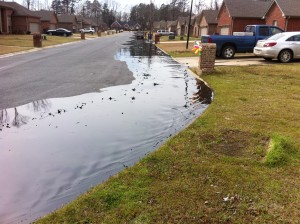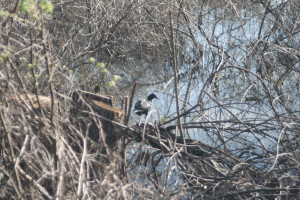We have much more to do and your continued support is needed now more than ever.
As Arkansas Community Reels from Tar Sands Oil Spill, Wildlife Remain in Peril

From that subdivision last Friday, the tar sands oil flowed down a storm drain, through a creek, and into a cove just before Lake Conway, a major sportfishing haven. Exxon Mobil crews are making a stand in that cove, hoping to keep the oil from flowing through a culvert under AR-89 and into Lake Conway. But that cove is also where tar sands oil-covered wildlife keep turning up — a fact Exxon Mobil can’t hide.
Community Hit Hard
Here in Mayflower, everyone’s happy to talk about how the spill has impacted them personally — but ask them to go on camera and they clam up. They know Exxon Mobil now has them over a barrel: the tar sands spill has left their homes somewhere on a scale between devalued and worthless, and an Exxon Mobil settlement is their best hope of getting that money back.
Joined by David Carruth, an Arkansas resident and member of the National Wildlife Federation’s board of directors, we walked into the local Hess gas station/bait shop to see if local sport fishermen had any insight into how local wildlife was faring. The man at the counter told us he lives on Starlite Drive, ground zero of the tar sands spill. He’s staying in a Holiday Inn Express in the next town over on Exxon Mobil’s tab while the cleanup continues.

I mentioned that Exxon Mobil and other tar sands transporters haven’t been paying into the Oil Spill Liability Trust Fund, claiming the provisions only cover conventional oil, not tar sands oil. He shook his head sadly. “My father landed on Omaha Beach. Back then, folks had a sense of civic duty.”
Wetlands Coated in Tar Sands Oil
From there, we headed to the cove to get a closer look. A homeowner pulled out her phone and showed us photos she’s taken of oiled birds and a muskrat in her backyard. She said she called state officials to report the oiled wildlife but was told they didn’t have the resources to respond. She then called the HAWK Center, which rescued several ducks. Yesterday — four days after the spill — Exxon Mobil finally set up its own wildlife rehabilitation center with an oiled wildlife hotline (1-800-876-9291) and took over cleaning wildlife from HAWK.

We pushed through the marsh around the edge of the cove, seeing a steady stream of oily spots and finding some tar balls. We then came upon a huge area of oiled marsh with cleanup crews working to remove as much tar sands oil as possible.
Two workers approached David and I thought for sure they’d tell us to scram. But it turned out they were wildlife rescuers asking if we’d seen any oiled wildlife. “I can’t believe how thick this stuff is,” one told David. “It’s like road tar — it’s nothing like motor oil.”
They estimated wildlife rescuers had found about 30 oiled ducks and other birds, a half-dozen oiled venomous snakes, and an oiled muskrat. They’d also spotted an oiled beaver out in the marsh, but said it was impossible to catch.
The sight of the heavily oiled marsh was a tragic reminder that cleaning 100% of this thick, sticky tar sands oil will likely be impossible; the impacts will be felt for months and possibly years to come.
The National Wildlife Federation will continue to monitor the impacts of the Arkansas tar sands oil spill. See more photos on Flickr and keep checking back to Wildlife Promise for updates.
Take Action
![]() It’s time for America to take a stand against tar sands oil – the risks to our wildlife, communities and clean water are just too great. Please take a moment now to ask President Obama to say no to the Keystone XL tar sands pipeline.
It’s time for America to take a stand against tar sands oil – the risks to our wildlife, communities and clean water are just too great. Please take a moment now to ask President Obama to say no to the Keystone XL tar sands pipeline.






















